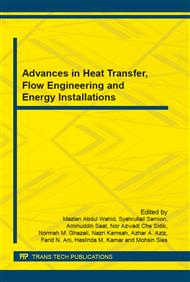[1]
Stobart, R. and R. Weerasinghe, Heat Recovery and Bottoming Cycles for SI and CI Engines- A Perspective. SAE Technical Paper, 2006(2006-01-0662).
DOI: 10.4271/2006-01-0662
Google Scholar
[2]
Saidur, R., et al., Technologies to recover exhaust heat from internal combustion engines. Renewable and Sustainable Energy Review, 2012. 16: pp.5649-5659.
DOI: 10.1016/j.rser.2012.05.018
Google Scholar
[3]
Noor, A.M., P.R. Che, and S. Rajoo, Waste Heat Recovery Technologies in Turbocharged Automotive Engine– A Review. Journal of Modern Science and Technology, 2014. 2(1): pp.108-119.
Google Scholar
[4]
Jianqin, F., et al., A Study on the Prospect of Engine Exhaust Gas Energy Recovery, in International Conference on Electric Information and Control Engineering (ICEICE). 2011: Wuhan, China. p.1960-(1963).
Google Scholar
[5]
Karri, M.A., E.F. Thacher, and B.T. Helenbrook, Exhaust Energy Conversion by Thermo- Electric Generator: Two Case Studies. Energy Conversion and Management, 2011. 52(3): pp.1596-1611.
DOI: 10.1016/j.enconman.2010.10.013
Google Scholar
[6]
Millo, F., et al., The Potential of Electric Exhaust Gas Turbocharging for HD Diesel Engines. SAE Technical Paper, 2006(2006-01-0437).
DOI: 10.4271/2006-01-0437
Google Scholar
[7]
Hopmann, U. and M.C. Algrain, Diesel Engine Electric Turbo Compound Technology. SAE International, 2003(2003-01-2294).
DOI: 10.4271/2003-01-2294
Google Scholar
[8]
Mori, M., et al., Current Possibilities of Thermoelectric Technology Relative to Fuel Economy. SAE Technical Paper, 2009( 2009-01-0170).
DOI: 10.4271/2009-01-0170
Google Scholar
[9]
Sendyka, B. and J. Soczwka. Recovery of Exhaust Gases Energy By Means of Turbocompound. in 6th Int. Symp. Diagnostics and Modeling of Combustion In Internal Combustion Engines. 2004. Yokohama, Japan.
DOI: 10.1299/jmsesdm.2004.6.99
Google Scholar
[10]
Mamat, A.M.I., et al., Design and Development of A Low Pressure Turbine for Turbocompounding Applications. International Journal of Gas Turbine, Propulsion and Power Systems, 2012. 4(3).
DOI: 10.38036/jgpp.4.3_1
Google Scholar
[11]
Hendricks, T. and W.T. Choates, Engineering Scoping Study of Thermoelectric Generator Systems for Industrial Waste Heat Recovery, U.D. o. Energy, Editor. 2006: USA.
DOI: 10.2172/1218711
Google Scholar
[12]
Stobart, R. and D. Milner, The Potential for Thermo-Electric Regeneration of Energy in Vehicles SAE Technical Paper, 2009(2009-01-1333).
DOI: 10.4271/2009-01-1333
Google Scholar
[13]
Patterson, A.T.C., R.J. Tett, and J. McGuire, Exhaust Heat Recovery using Electro-Turbogenerators. SAE Technical Paper, 2009(2009-01-1604).
DOI: 10.4271/2009-01-1604
Google Scholar
[14]
Riffat, S.B. and X. Ma, Thermoelectrics: A Review of Present and Potential Applications. Applied Thermal Engineering, 2003. 23(8): pp.913-935.
DOI: 10.1016/s1359-4311(03)00012-7
Google Scholar
[15]
Hussain, Q.E., D.R. Brigham, and C.W. Maranville, Thermoelectric Exhaust Heat Recovery for Hybrid Vehicles. SAE Technical Paper, 2009(2009-01-1327).
DOI: 10.4271/2009-01-1327
Google Scholar
[16]
Stobart, R.K., A. Wijewardane, and C. Allen, The Potential for Thermoelectric Devices in Passenger Vehicle Applications. SAE Technical Paper 2010(2010-01-0833).
DOI: 10.4271/2010-01-0833
Google Scholar
[17]
Yang, J. and F.R. Stabler, Automotive Applications of Thermoelectric Materials. Journal of Electronic Materials, 2009. 38(7).
Google Scholar
[18]
Mamat, A.M.I., Design and Development of a High Performance LPT for Electric Turbo-compounding Energy Recovery Unit in a Heavily Downsized Engine. 2011, Imperial College London.
Google Scholar
[19]
King, J., et al. HyBoost – An intelligently electrified optimised downsized gasoline engine concept. in 10th International Conference of Turbochargers and Turbocharging. 2012. Proceedings of the Institution of Mechanical Engineers.
DOI: 10.1533/9780857096135.1.3
Google Scholar


